To listen to RTÉ.ie's radio and podcast services, you will need to disable any ad blocking extensions or whitelist this site.

0
00:00
00:00
Episode Notes
Panel: Richard Collins, Éanna Ní Lamhna & Niall Hatch
Researcher: Michele Browne
In addition to listening to us on RTÉ Radio One at 22:00 every Monday night, don't forget that you can also listen back to each of our programmes any time you like at http://rte.ie/mooney. There, you will find an extensive archive of past broadcasts, conveniently split into different topics and segments.
On tonight’s programme, we feature a query from one of our listeners about the Magpie, a highly (and almost scarily) intelligent bird that is a common sight across the country. With this in mind, our suggestion for you this week from the Mooney Goes Wild archives is a documentary all about these utterly amazing members of the crow family. It is presented by Terry Flanagan and was first broadcast on 1st April 2024.
To listen to this documentary from the Mooney Goes Wild archives, visit
https://rte.ie/radio/radio1/clips/22378928/
Let’s talk about birds
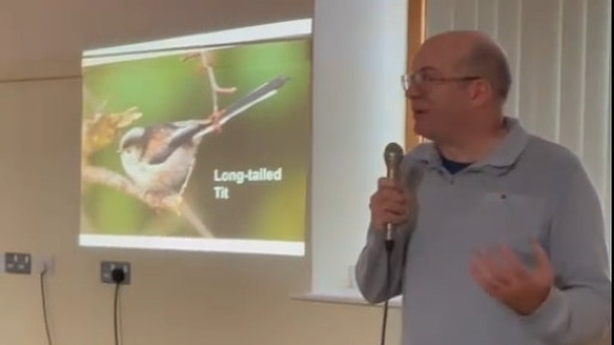
As his day job, regular Mooney Goes Wild panellist Niall Hatch is Head of Communications and Development with BirdWatch Ireland, Ireland’s largest conservation charity. As part of his responsibilities, when time in his very busy schedule permits, he loves nothing better to give talks to active retirement associations, tidy towns groups, golf clubs, schools, scout troops and other local groups all about (what else?) birds.
This is all part of BirdWatch Ireland’s mission to inform people across the country about our feathered friends, to help them to identify and to care for them and, crucially, to recruit as many new BirdWatch Ireland members as possible to join the organisation and, through their annual membership subscription fees, to support the conservation of Ireland’s wild birds and their habitats.
On tonight’s programme, Niall tells us about a talk on the topic of Irish Garden Birds that he gave to Bray Active Retirement Association in Co. Wicklow, an extract from which we will feature at the end of the show.
For more information about becoming a member of BirdWatch Ireland and supporting its vital conservation work, visit https://birdwatchireland.ie/get-involved/join-us-become-a-member/
Separating the wheat from the chaff: what bird says "pink . . . pink . . . pink"?
While walking recently on the slopes of Musheramore in Co. Cork, Derek heard a very distinctive bird call: a strident, emphatic and almost metallic-sounding "pink . . . pink . . . pink". He was able to record the sound with his phone, and on tonight’s programme he challenges Richard and Niall to identify it.
As both of the experienced "birders" immediately discern, it is the call of a Chaffinch, one of the most common of all Irish bird species. Languages corrupt and evolve, and over time the bird that was known for saying "pink", or perhaps "fink", had the ending of its call softened to "pinch" . . . or "finch". The call of the Chaffinch that Derek recorded is the very reason that the 235 species in the finch family found globally are called "finches".
For more information about Chaffinches, visit
https://birdwatchireland.ie/birds/chaffinch
Queries from our listeners
Here at Mooney Goes Wild, we receive a huge amount of letters, emails and social media queries from you, our loyal listeners. On tonight’s programme, our researcher Michele Browne brings us a selection of the natural history questions that you have posed to our expert panellists.
A Greenfinch that is feeling blue
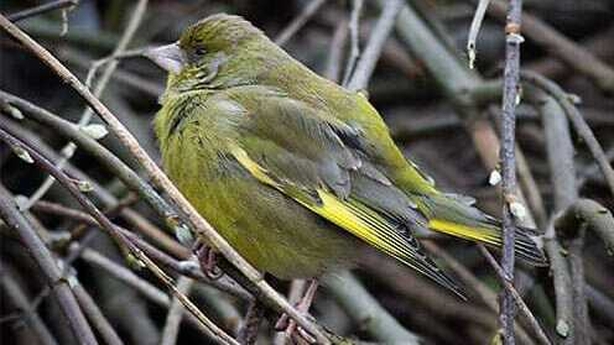
One of our listeners, Sandra Macken from Dublin, sent us a fine photo of a male Greenfinch that visited her garden. Unfortunately, as some of our social media followers were able to tell, the unfortunate bird was suffering from a nasty bird disease (which, we wish to assure you, poses no threat whatsoever to us humans, nor to our fellow mammals) called Trichomoniasis.
This avian disease has no cure, and sadly the majority of birds affected by it quickly perish. To help to prevent its spread, we urge everyone regularly to clean and disinfect their bird feeders and water dishes and, if sick birds are seen, completely to halt feeding garden birds for at least three weeks.
For more information about trichomoniasis and the steps that you can take to minimise the impact of this nasty bird disease, visit
For more information about Greenfinches, visit
https://birdwatchireland.ie/birds/greenfinch/
Sociable Magpies
One of our listeners called Gráinne Clancy was in touch to tell us about a remarkable gathering of approximately 18 Magpies that she felt were "having a chat" on a road near her home. What, she wonders, was going on?
As Richard explains, Magpies are gregarious birds that like to gather together in flocks, ostensibly to share gossip. Presumably, the spectacle that Gráinne witnessed was one of the congregations that these highly intelligent black-and-white birds form, though the actual reasons for their desire to meet up and, apparently, converse remain unknown to us. Perhaps they are talking about us behind our backs!
For more information about Magpies, visit
https://birdwatchireland.ie/birds/magpie/
Peacock Butterfly in April
One of our listeners, Annette McCormack, sent us a lovely photo of a Peacock butterfly, which she photographed on 1st April this year. She wanted to know whether it had appeared early this year.
On tonight’s programme, our panellists discuss how climate change may be causing some of our butterflies to appear earlier in the year than they used to, as well as the fascinating life-cycle of the Peacock, one of our most common and easily identified Irish butterflies.
For more information about Peacock butterflies in Ireland, visit
http://www.irishbutterflies.com/peacock_butterfly_of_ireland.html
A (tree)creepy photo from
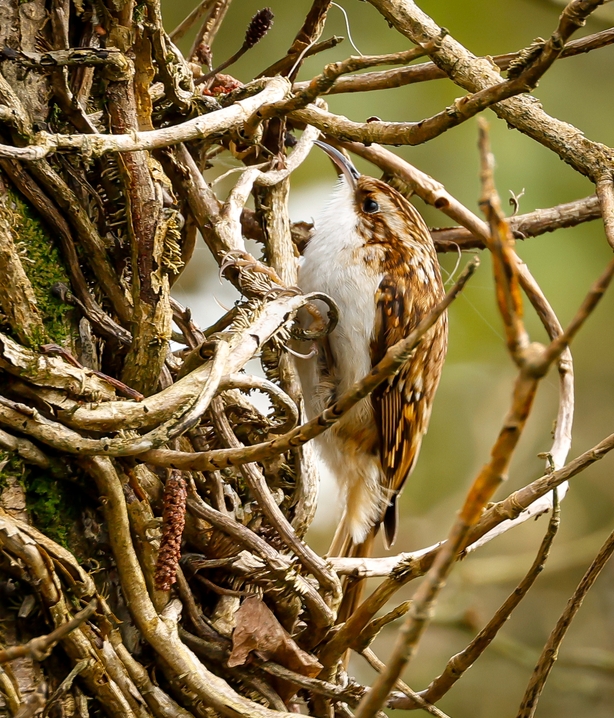
Another listener, Daniel Hogan, sent us another lovely photo, this time of a small bird called a Treecreeper, which, though quite common in Ireland, is a notoriously difficult species to capture on camera.
As Niall tells us on tonight’s programme, the lives of Treecreepers revolve pretty much entirely around bark, which provides them with their ideal foraging, protective and nesting habitat. Due to their excellent camouflage, these highly arboreal birds are very difficult to observe, let alone photograph, so Daniel definitely did very well.
For more information about Treecreepers, visit
https://birdwatchireland.ie/birds/treecreeper/
Looking forward to the Dawn Chorus
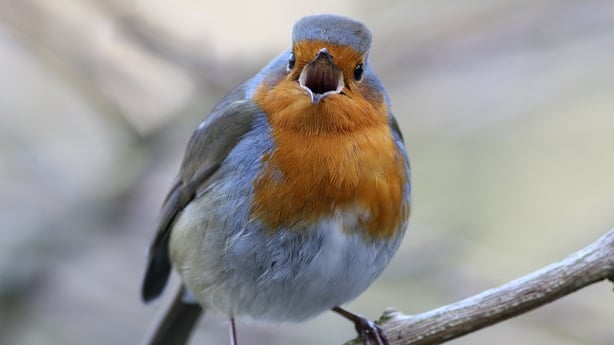
Marina Everitty from Stockholm was in touch with our team, wanting to know the date of our much-anticipated live Dawn Chorus programme this year, further telling is that she celebrated her 80th birthday in Cork last year and that it was a wonderful experience to be back in Ireland again.
As a belated birthday gift, we are delighted to let Marina know that this year’s Dawn Chorus broadcast is just around the corner. It will be taking place on RTÉ Radio One from midnight to 07:00 on International Dawn Chorus Day, Sunday 5th May, in a simulcast with our colleagues at RTÉ Lyric FM and BBC Radio Wales.
The dawn chorus is one of the most magical experiences in nature: a multitude of birds of many different species all singing together in harmony as morning breaks and light begins to fill the skies. As our natural world’s most impressive and renowned concert, it is almost as though it has been tailor-made for radio. It never ceases. It moves, with the early morning light, like a great wave on the face of the Earth. It is quite literally the sound of our planet rotating on its axis.
While Derek Mooney steers the ship from the RTÉ Radio Centre in Dublin, 'home base’ for the live broadcast once again this year will be BirdWatch Ireland’s Cuskinny Marsh Nature Reserve in Cobh, Co. Cork, where our main presentation team of Jim Wilson and Niall Hatch will introduce the dawn chorus and, while the birdsong builds in real time, explain to listeners what our feathered friends are getting up to as the sun rises.
Across the country, Richard Collins, Éanna Ní Lamhna, Eric Dempsey and Terry Flanagan will also bring us the birdsong from their parts of Ireland, as the sun gradually breaks the horizon and the birds begin their performances.
For more information about the phenomenon of the dawn chorus broadcast, visit
https://rte.ie/lifestyle/nature/2018/0413/954360-what-is-the-dawn-chorus-derek-mooney-explains/
Hooded Crow nesting strategies
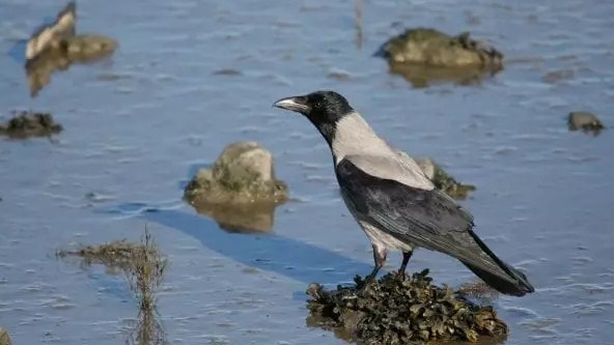
On their weekly walk in Fairview Park recently, Derek and Richard came upon a rather untidy nest, high on an electricity pylon. It was the nest of a pair of Hooded Crows, and on tonight’s programme we learn all about the nesting habits of these widespread and familiar Irish birds . . . as well as some of the perils birds risk when nesting around high-voltage electricity.
For more information about Hooded Crows, visit
https://birdwatchireland.ie/birds/hooded-crow/
Getting to know one of our rarest insects, the Great Yellow Bumblebee

An Bhumbóg Mór Bhuí is a fantastic new children’s book by Katherine Mangan and Margaret Tallot, with superb illustrations by Jean Beard. Self-published by Baile Slachtmhar Bhéal an Mhuirthead (Belmullet Tidy Towns), this wonderful bilingual tome, in both Irish and English, has been designed to inform young readers and their parents about a species that specialises on Ireland’s valuable machair habitat and for which the Mullet Peninsula of Co. Mayo is of enormous national importance.
On tonight’s programme, Éanna speaks to Margaret all about this wonderful new book and the local efforts to save this fascinating bee.
For more information about An Bhumbóg Mór Bhuí, visit
https://belmullettidytowns.com/great-yellow-bumblebee
Ireland’s Garden Birds
As mentioned above, as part of his work for BirdWatch Ireland, our very own Niall Hatch recently gave a talk all about Ireland’s Garden Birds to the members of the Bray Active Retirement Association in Co. Wicklow. On tonight’s programme, we are pleased to bring you a portion of Niall’s talk.
For more information about Ireland’s garden birds, visit
https://birdwatchireland.ie/irelands-birds-birdwatch-ireland/garden-birds/
For more information about BirdWatch Ireland and its crucial work to protect and conserve Ireland’s wild birds and their habitats, visit
